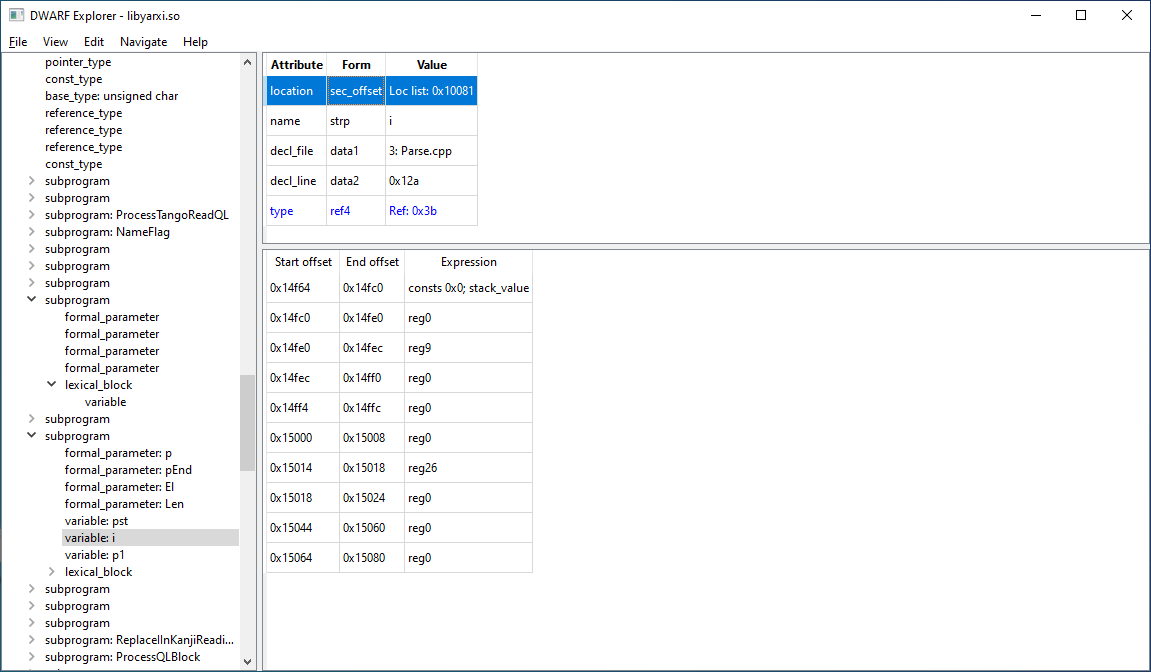GUI viewer for DWARF debug information
Project description
DWARF Explorer
A cross-platform GUI utility for visualizing the DWARF debugging information in executable files, built on top of pyelftools and filebytes. Runs on Windows, MacOS X, and Linux. Supports parsing the following file types for DWARF data:
- ELF (Linux, Android)
- Mach-O (MacOS X, iOS)
- PE (Windows, Cygwin)
This project came from my desire to see and navigate the DWARF tree of compiled Android and iOS binaries. Seeing the DIEs is easy enough with utilities like readelf or dwarfdump. However, chasing inter-DIE references back and forth is not straightforward with those.
The utility might be of use for anyone who is building DWARF parsers for one or another reason, especially if their preferred parsing library is pyelftools.
Note that regular Windows executables (EXE/DLL files) are PE files but don't, as a rule, contain DWARF information. The Microsoft toolchains (Visual Studio and the like) produce debugging information in Microsoft's own format, Program Database (PDB). There are, though, a couple of toolchains that produce PE files with DWARF debug info in them - notably GCC under Cygwin. DWARF Explorer is compatible with those.
The pyelftools library that dwex is based on supports DWARF versions 2-4, and so does dwex. DWARF v5 exists, and will be eventually supported; feel free to upvote the request for it. DWARF v1 is supported experimentally, in ELF files only.
Requirements and Dependencies
- Python 3.5+
- PyQt5
- filebytes 0.10.1+
- pyelftools 0.27+
Installation
If necessary, install the latest Python in the way that's appropriate for your OS. Run pip install dwex from the command line, under sudo or elevated command line if necessary.
On Windows, if pip and/or Python is not in PATH, use c:\Python39\python -m pip install dwex, substituting your own path to Python 3.
Alternatively, get the dwex source tree from Github, and run python setup.py install in the root folder of the package. In this scenario, you'd have to install the dependencies separately - with pip install pyqt5 filebytes pyelftools.
On Linux, sometimes the python command defaults to Python 2 while Python 3 is installed side by side. In this case, use python3 and pip3, respectively. Use python -V to check.
Once you install it, there will be a dwex command. On Windows, there will be a dwex.exe in the Scripts folder under the Python folder, and also a start menu item "DWARF Explorer".
Usage
Click Open in the File menu, choose your executable, and eyeball the DWARF tree. Alternatively, drag and drop an executable onto the main window. You can open by dropping a dSYM bundle folder, too.
On the most basic level, the debug information in a compiled file is an array of compilation units (CUs). Each CU contains a tree of data items called Debugging Information Entries (DIEs). Each DIE has a title called tag, and contains a name-value dictionary called attributes. Each CU has exactly one root DIE, and the rest of the DIEs are in its subtree.
The UI of DWARF Explorer was meant for eyeballing that data structure:
The left hand tree displays the DIEs, with CU root DIEs on the top level. Expand the tree and click on DIEs to see their attributes. DIE attributes that have a substructure or point at larger data structures are clickable.
DIEs generally correspond to source level entities in the program - variables, functions, classes, members, methods, etc. The DIE tag tells you which one is it. The exact way the compiler builds a DIE tree to describe the program varies between source languages, compiler versions, target platforms and architectures. The official home of the DWARF spec is at dwarfstd.org, but there's considerable leeway for implementations to improvise upon. On top of that, the DWARF spec contains explicit extension points for compiler vendors to tap into.
DIE attribute values are relatively small scalars - integers, strings, sometimes short byte arrays. However, they sometimes refer at larger data structures. Physically, it's an integer, but logically, it's a pointer to some data elsewhere. Also, DIE attribute values may contain references to other DIEs - for example, a DIE for a variable would contain a reference to a DIE that describes its datatype. DIE attributes that contain references to other DIEs are rendered in blue; the link can be followed by a double-click or a Ctrl+Enter. To come back to the original DIE, use Navigate/Back, the Back mouse button, or an appropriate keyboard shortcut (Alt-Left on Windows and Linux, Ctrl-[ on Mac).
In DWARF, tag and attribute names are prefixed with DW_TAG_ and DW_AT_, respectively. DWARF Explorer elides those by default to reduce visual clutter. Use View/DWARF prefix in the menu to bring them back.
Disclaimer
This project is unrelated to ragundo/DwarfExplorer. That one deals with a different kind of dwarves. Although, interestingly enough, they also use the Qt library for their GUI.
Project details
Release history Release notifications | RSS feed
Download files
Download the file for your platform. If you're not sure which to choose, learn more about installing packages.












